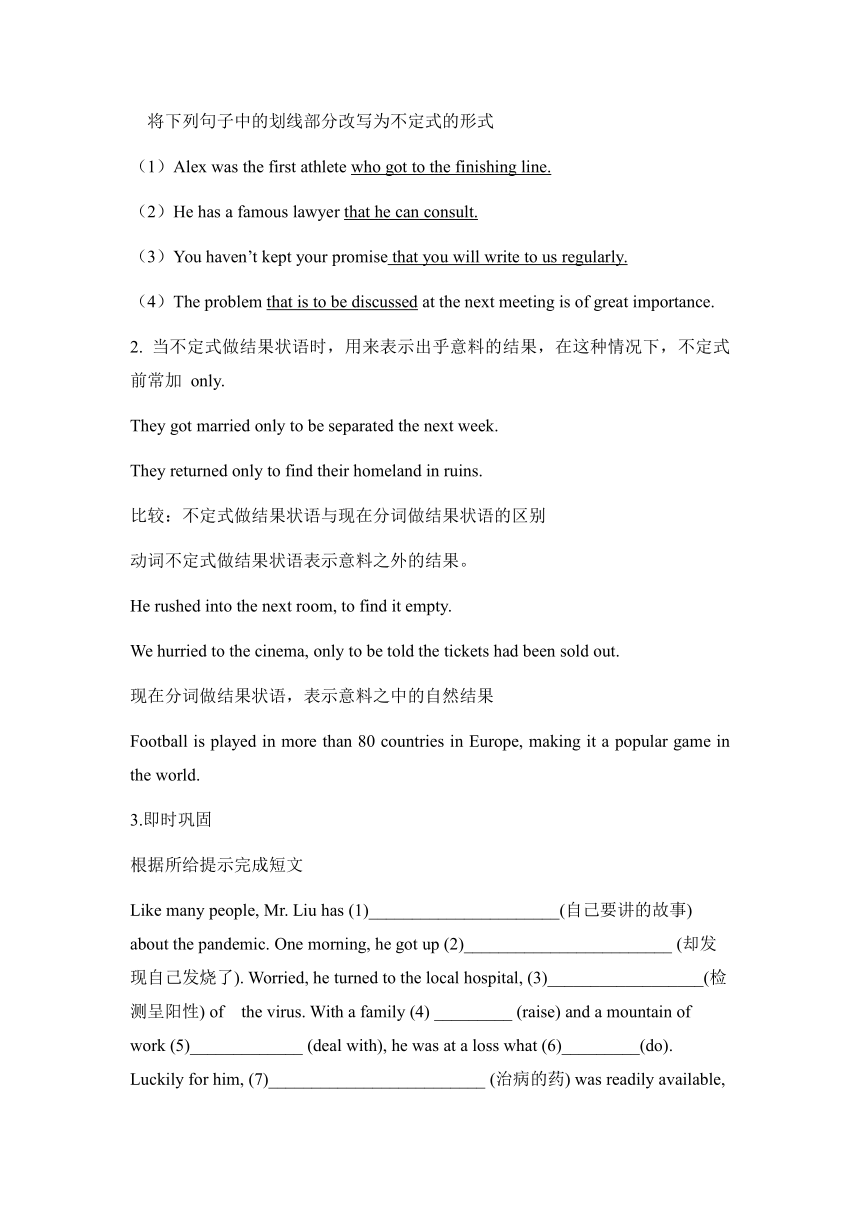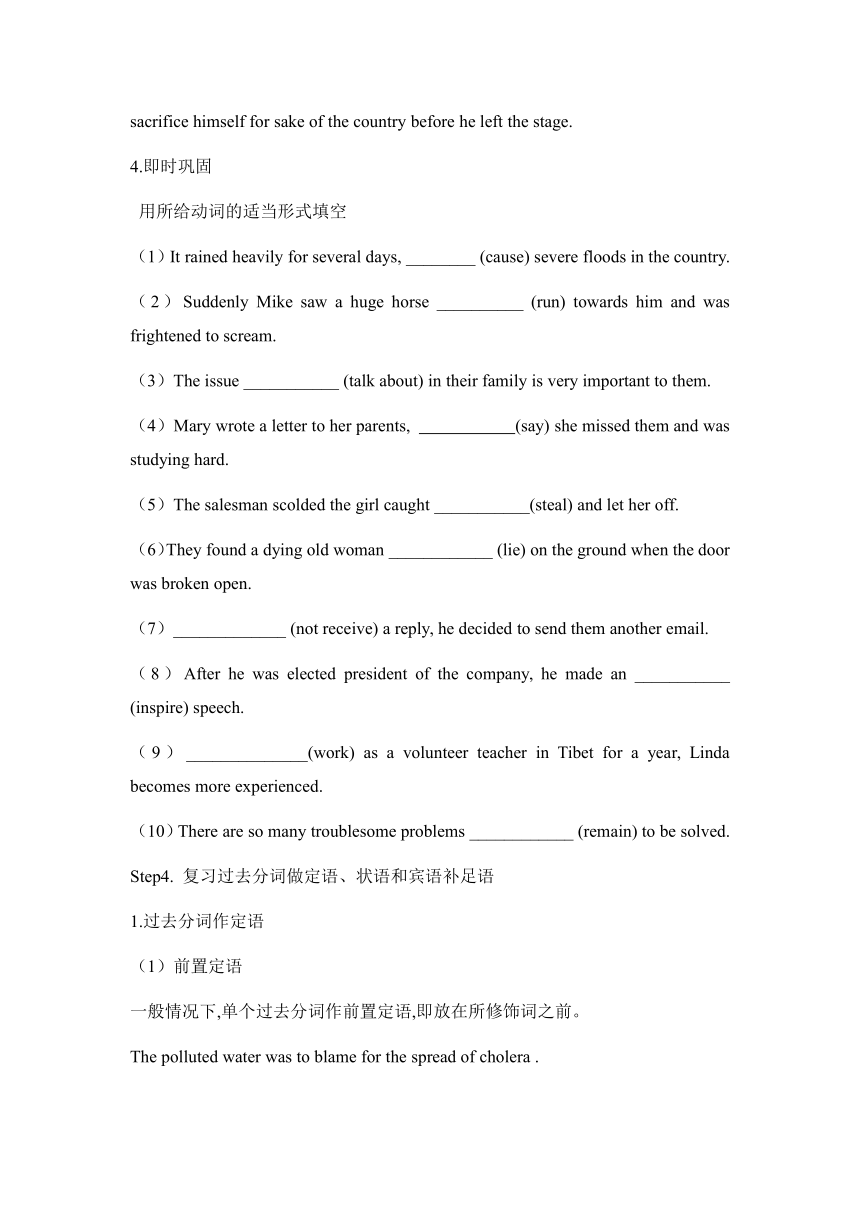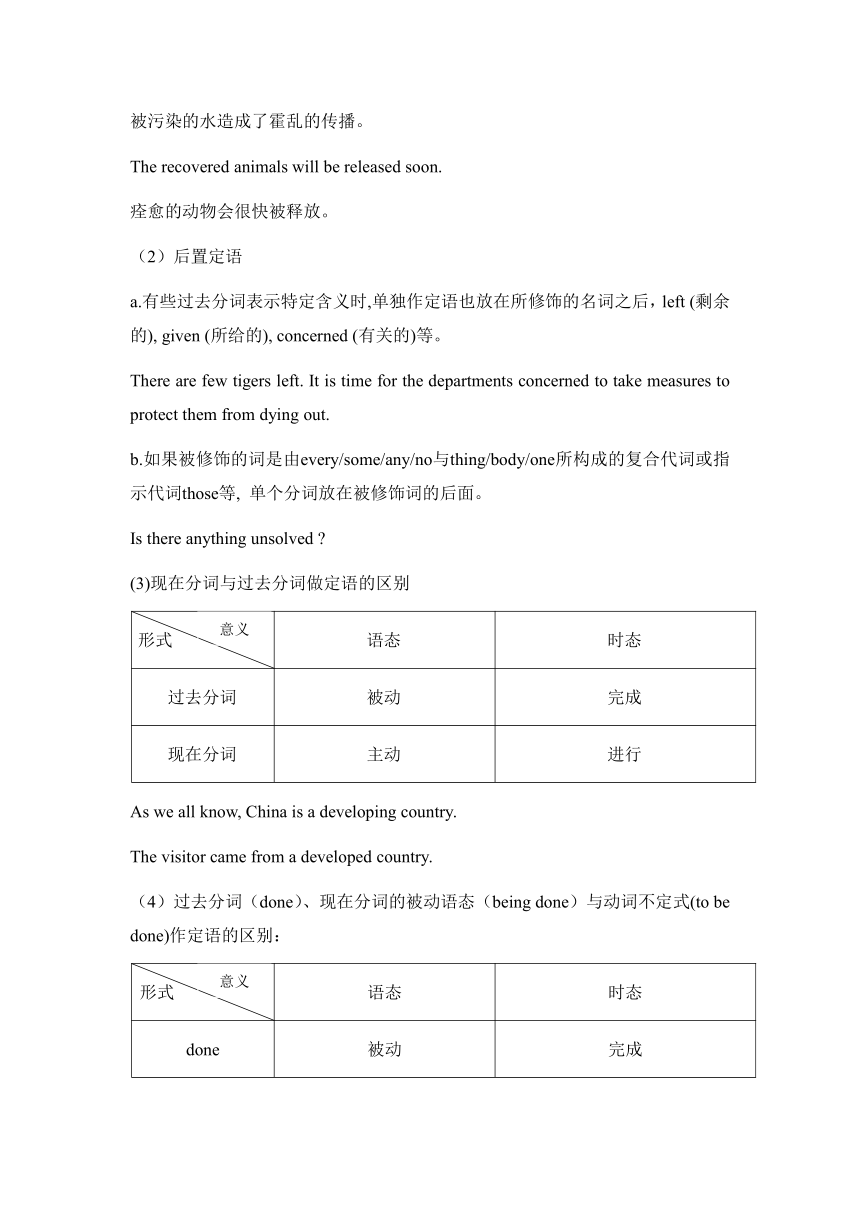2020-2021学年牛津版(2019)高中英语必修三:语法专项复习——非谓语动词 学案(含答案)
文档属性
| 名称 | 2020-2021学年牛津版(2019)高中英语必修三:语法专项复习——非谓语动词 学案(含答案) |  | |
| 格式 | docx | ||
| 文件大小 | 29.3KB | ||
| 资源类型 | 教案 | ||
| 版本资源 | 牛津译林版(2019) | ||
| 科目 | 英语 | ||
| 更新时间 | 2021-08-15 15:04:34 | ||
图片预览





文档简介
2020-2021学年牛津版(2019)高中英语必修三:
语法专项复习——非谓语动词学案
教学目标:
By the end of this section, students will be able grasp
1. to-infinitives as attributives and adverbials of result.
2. verb-ing forms as attributives, adverbials and object complements.
3. verb-ed forms as attributives, adverbials and object complements.
教学重点:
The usage of the to-infinitives, verb-ing forms and verb-ed forms.
教学难点:
How to distinguish predicate from non-predicate and how to use the non-predicate correctly.
教学过程:
Step1. 导入
划出下列句子中的谓语和非谓语
1. The girl making up is very lovely.
2. We enjoyed the show given by the students.
3. Before the performance, she practiced many times to make sure that she could dance perfectly.
总结:谓语动词:在句子中充当谓语的动词。
非谓语动词:在句中不充当谓语的动词。
Step2. 复习不定式做定语和结果状语
1. 不定式做定语常放在其所修饰的名词或代词之后, 相当于一个定语从句。
将下列句子中的划线部分改写为不定式的形式
(1)Alex was the first athlete who got to the finishing line.
(2)He has a famous lawyer that he can consult.
(3)You haven’t kept your promise that you will write to us regularly.
(4)The problem that is to be discussed at the next meeting is of great importance.
2. 当不定式做结果状语时,用来表示出乎意料的结果,在这种情况下,不定式前常加 only.
They got married only to be separated the next week.
They returned only to find their homeland in ruins.
比较:不定式做结果状语与现在分词做结果状语的区别
动词不定式做结果状语表示意料之外的结果。
He rushed into the next room, to find it empty.
We hurried to the cinema, only to be told the tickets had been sold out.
现在分词做结果状语,表示意料之中的自然结果
Football is played in more than 80 countries in Europe, making it a popular game in the world.
3.即时巩固
根据所给提示完成短文
Like many people, Mr. Liu has (1)______________________(自己要讲的故事) about the pandemic. One morning, he got up (2)________________________ (却发现自己发烧了). Worried, he turned to the local hospital, (3)__________________(检测呈阳性) of the virus. With a family (4) _________ (raise) and a mountain of work (5)_____________ (deal with), he was at a loss what (6)_________(do). Luckily for him, (7)_________________________ (治病的药) was readily available, and he has a lot of relatives and friends (8)_______________(支持他). Now that he has totally recovered, Liu thinks there are important lessons (9)___________(learn) from the pandemic. “Whatever your social status is, however much money you make, health is always the most important thing (10)____________ (care about),” he says.
Step3.复习现在分词做定语、状语和宾语补足语
1.现在分词做定语
单个现在分词放在被修饰词之前,现在分词短语放在被修饰词之后。
(1) a crying baby (1) children sitting there
(2) an exciting movie (2) shoes lying on the floor
(3) some shocking news (3)the man standing by the window
2. 现在分词做宾语补足语
(1)及物动词+宾语+宾补
I find the baby crying.
The naughty boys send the papers flying in all directions.
(2)with+宾语+现在分词
He left the room with the lamp burning.
They went to the forest with the boy leading the way.
3.现在分词做状语
现在分词或现在分词短语做状语的时候,可以放在句首、句中、句尾,它的逻辑主语与句子的主语一致。
(1) Hearing the bad news, he burst into tears.
(2) The audience left the amphitheater, still talking about the performance, and soon disappeared into the darkness.
(3) The president finished delivering a national address, adding that he was willing to sacrifice himself for sake of the country before he left the stage.
4.即时巩固
用所给动词的适当形式填空
(1)It rained heavily for several days, ________ (cause) severe floods in the country.
(2)Suddenly Mike saw a huge horse __________ (run) towards him and was frightened to scream.
(3)The issue ___________ (talk about) in their family is very important to them.
(4)Mary wrote a letter to her parents, (say) she missed them and was studying hard.
(5)The salesman scolded the girl caught ___________(steal) and let her off.
(6)They found a dying old woman ____________ (lie) on the ground when the door was broken open.
(7)_____________ (not receive) a reply, he decided to send them another email.
(8)After he was elected president of the company, he made an ___________ (inspire) speech.
(9)______________(work) as a volunteer teacher in Tibet for a year, Linda becomes more experienced.
(10)There are so many troublesome problems ____________ (remain) to be solved.
Step4. 复习过去分词做定语、状语和宾语补足语
1.过去分词作定语
(1)前置定语
一般情况下,单个过去分词作前置定语,即放在所修饰词之前。
The polluted water was to blame for the spread of cholera .
被污染的水造成了霍乱的传播。
The recovered animals will be released soon.
痊愈的动物会很快被释放。
(2)后置定语
a.有些过去分词表示特定含义时,单独作定语也放在所修饰的名词之后,left (剩余的), given (所给的), concerned (有关的)等。
There are few tigers left. It is time for the departments concerned to take measures to protect them from dying out.
b.如果被修饰的词是由every/some/any/no与thing/body/one所构成的复合代词或指示代词those等, 单个分词放在被修饰词的后面。
Is there anything unsolved ?
(3)现在分词与过去分词做定语的区别
意义
形式
语态
时态
过去分词
被动
完成
现在分词
主动
进行
As we all know, China is a developing country.
The visitor came from a developed country.
(4)过去分词(done)、现在分词的被动语态(being done)与动词不定式(to be done)作定语的区别:
意义
形式
语态
时态
done
被动
完成
being done
被动
进行
to be done
被动
尚未发生
The building built last year is our classroom building.
去年建造的楼是我们的教学楼。
The building being built now is our classroom building.
现在正在建造的楼是我们的教学楼。
The building to be built next month is our classroom building.
下个月将要建造的楼是我们的教学楼。
2.过去分词作状语
过去分词(短语)作状语,表示被动的或完成的动作, 这时句子的主语和过去分词之间为逻辑上的被动关系。
Written in a hurry, this article was not so good.
过去分词通常在句中作时间、原因、条件、让步、方式和伴随状语等。
Asked about his address ( = When he was asked about his address ) , the boy didn ' t respond .
Annoyed at the decision ( = As he was annoyed at the decision ) , he refused to attend the meeting .
Given more time ( = If they were given more time ) , the trees could grow taller .
Though having been warned of the storm ( = Though they had been warned of the storm ) , the farmers were still working in the fields .
Followed by a group of students, the teacher entered the classroom .
= The teacher entered the classroom and he was followed by a group of students.
注意:过去分词(短语)作状语时, 前面有时可以加上 when , if , while , though , even if , until , unless等连词, 这种结构可以看作是一种省略的状语从句(省略部分多为“主语+be的多种形式”)。需要注意的是, 省略的主语必须和主句的主语相同或为it。
Even if invited ( = Even if I ' m invited ) , I won ' t take part in the party .
即使受到邀请,我也不会参加那个聚会的。
即时巩固
用所给动词的适当形式填空完成短文
I tried the number?(1) (print)?in the name card. A man picked up the phone, (2) (answer)?in an anxious voice. (3) (explain) everything,?(4) (ask)him to calm down,?(5) (tell) him where I was, I promised (6) (wait) for him. (7) (?hear) my words, he calmed down a little,?(8) (thank)me again and again,
(9) (promise)to come immediately before?hanging up?the phone.
An hour later, I saw a man?(10) (run)?towards me.
(11) (recognize)?his voice, (12) (match)?the information on the name card,?(13) (make) sure?he was the owner, I handed him the wallet. He thanked me again and again,?(14) (hold) his thumbs-up,?(15) (praise) me,?smiling?happily.?I felt proud of myself.
3. 过去分词作宾补
(1)放在表状态的动词keep, leave 等后;
(2)放在使役动词have\get, keep和make后;
(3)放在see, hear, watch, find, feel等感官动词后;
(4)放在order,wish等表意愿、命令的动词后;
(5)用在with的复合结构中。
即时巩固
用所给动词的适当形式填空
(1)He got up late and hurried to his office, leaving the breakfast (touch).
(2)Claire had her luggage (check) an hour before her plane left.
(3)While they were on holiday, they had their car (break) into.
(4)They managed to make themselves (understand) by using very simple English.
(5)When we saw the road (block)with snow, we decided to spend the holiday at home.
(6)The manager ordered the work (finish)at the end of this week.
(7)John received an invitation to dinner, and with his work (finish), he gladly accepted it.
Step5. 微写作练习
将下面三句话用非谓语动词合并成一句。
Poppy was fascinated by the adorable puppy. She stared at him feverishly. Then she bounced around with energy on the?soft pads.?
__________________________________________________________________________________________________________________________________________
用with的复合结构合并成一句。
Tears welled up their eyes. The couple hugged tightly. They promised not to lose their temper and do the silly thing again.
__________________________________________________________________________________________________________________________________________
参考答案:
Step 2.
1.将下列句子中的划线部分改写为不定式的形式
(1)to get to the finishing line.
(2) to consult
(3) to write to us regularly
(4) to be discussed
3.即时巩固
根据所给提示完成短文
(1) his own story to tell (2) only to find himself having a fever
(3) only to be tested positive (4) to raise
(5) to deal with (6) to do
(7) the medicine to cure the disease (8) to support him
(9) to learn (10) to care about
Step3.
4.即时巩固
用所给动词的适当形式填空
(1) causing (2) running
(3) being talked about (4) saying
(5) stealing (6) lying
(7) Not having received (8) inspiring
(9) Having worked (10) remaining
Step4.
即时巩固
用所给动词的适当形式填空完成短文
(1) printed (2) answering
(3) explaining (4) asking
(5) telling (6) to wait
(7) Having heard (8) thanking
(9) promising (10) running
(11) Recognizing (12) matching
(13) making (14) holding
(15) praising
即时巩固
用所给动词的适当形式填空
(1) touched (2) checked
(3) broken (4) understood
(5) blocked (6) finished
(7) finished
Step5.微写作练习
(1) Fascinated by the adorable puppy, Poppy stared at him feverishly, bouncing around with energy on the soft pads.
(2) Spotting the puppy, Poppy was enraptured, with her eyes becoming mellow and affectionate.
语法专项复习——非谓语动词学案
教学目标:
By the end of this section, students will be able grasp
1. to-infinitives as attributives and adverbials of result.
2. verb-ing forms as attributives, adverbials and object complements.
3. verb-ed forms as attributives, adverbials and object complements.
教学重点:
The usage of the to-infinitives, verb-ing forms and verb-ed forms.
教学难点:
How to distinguish predicate from non-predicate and how to use the non-predicate correctly.
教学过程:
Step1. 导入
划出下列句子中的谓语和非谓语
1. The girl making up is very lovely.
2. We enjoyed the show given by the students.
3. Before the performance, she practiced many times to make sure that she could dance perfectly.
总结:谓语动词:在句子中充当谓语的动词。
非谓语动词:在句中不充当谓语的动词。
Step2. 复习不定式做定语和结果状语
1. 不定式做定语常放在其所修饰的名词或代词之后, 相当于一个定语从句。
将下列句子中的划线部分改写为不定式的形式
(1)Alex was the first athlete who got to the finishing line.
(2)He has a famous lawyer that he can consult.
(3)You haven’t kept your promise that you will write to us regularly.
(4)The problem that is to be discussed at the next meeting is of great importance.
2. 当不定式做结果状语时,用来表示出乎意料的结果,在这种情况下,不定式前常加 only.
They got married only to be separated the next week.
They returned only to find their homeland in ruins.
比较:不定式做结果状语与现在分词做结果状语的区别
动词不定式做结果状语表示意料之外的结果。
He rushed into the next room, to find it empty.
We hurried to the cinema, only to be told the tickets had been sold out.
现在分词做结果状语,表示意料之中的自然结果
Football is played in more than 80 countries in Europe, making it a popular game in the world.
3.即时巩固
根据所给提示完成短文
Like many people, Mr. Liu has (1)______________________(自己要讲的故事) about the pandemic. One morning, he got up (2)________________________ (却发现自己发烧了). Worried, he turned to the local hospital, (3)__________________(检测呈阳性) of the virus. With a family (4) _________ (raise) and a mountain of work (5)_____________ (deal with), he was at a loss what (6)_________(do). Luckily for him, (7)_________________________ (治病的药) was readily available, and he has a lot of relatives and friends (8)_______________(支持他). Now that he has totally recovered, Liu thinks there are important lessons (9)___________(learn) from the pandemic. “Whatever your social status is, however much money you make, health is always the most important thing (10)____________ (care about),” he says.
Step3.复习现在分词做定语、状语和宾语补足语
1.现在分词做定语
单个现在分词放在被修饰词之前,现在分词短语放在被修饰词之后。
(1) a crying baby (1) children sitting there
(2) an exciting movie (2) shoes lying on the floor
(3) some shocking news (3)the man standing by the window
2. 现在分词做宾语补足语
(1)及物动词+宾语+宾补
I find the baby crying.
The naughty boys send the papers flying in all directions.
(2)with+宾语+现在分词
He left the room with the lamp burning.
They went to the forest with the boy leading the way.
3.现在分词做状语
现在分词或现在分词短语做状语的时候,可以放在句首、句中、句尾,它的逻辑主语与句子的主语一致。
(1) Hearing the bad news, he burst into tears.
(2) The audience left the amphitheater, still talking about the performance, and soon disappeared into the darkness.
(3) The president finished delivering a national address, adding that he was willing to sacrifice himself for sake of the country before he left the stage.
4.即时巩固
用所给动词的适当形式填空
(1)It rained heavily for several days, ________ (cause) severe floods in the country.
(2)Suddenly Mike saw a huge horse __________ (run) towards him and was frightened to scream.
(3)The issue ___________ (talk about) in their family is very important to them.
(4)Mary wrote a letter to her parents, (say) she missed them and was studying hard.
(5)The salesman scolded the girl caught ___________(steal) and let her off.
(6)They found a dying old woman ____________ (lie) on the ground when the door was broken open.
(7)_____________ (not receive) a reply, he decided to send them another email.
(8)After he was elected president of the company, he made an ___________ (inspire) speech.
(9)______________(work) as a volunteer teacher in Tibet for a year, Linda becomes more experienced.
(10)There are so many troublesome problems ____________ (remain) to be solved.
Step4. 复习过去分词做定语、状语和宾语补足语
1.过去分词作定语
(1)前置定语
一般情况下,单个过去分词作前置定语,即放在所修饰词之前。
The polluted water was to blame for the spread of cholera .
被污染的水造成了霍乱的传播。
The recovered animals will be released soon.
痊愈的动物会很快被释放。
(2)后置定语
a.有些过去分词表示特定含义时,单独作定语也放在所修饰的名词之后,left (剩余的), given (所给的), concerned (有关的)等。
There are few tigers left. It is time for the departments concerned to take measures to protect them from dying out.
b.如果被修饰的词是由every/some/any/no与thing/body/one所构成的复合代词或指示代词those等, 单个分词放在被修饰词的后面。
Is there anything unsolved ?
(3)现在分词与过去分词做定语的区别
意义
形式
语态
时态
过去分词
被动
完成
现在分词
主动
进行
As we all know, China is a developing country.
The visitor came from a developed country.
(4)过去分词(done)、现在分词的被动语态(being done)与动词不定式(to be done)作定语的区别:
意义
形式
语态
时态
done
被动
完成
being done
被动
进行
to be done
被动
尚未发生
The building built last year is our classroom building.
去年建造的楼是我们的教学楼。
The building being built now is our classroom building.
现在正在建造的楼是我们的教学楼。
The building to be built next month is our classroom building.
下个月将要建造的楼是我们的教学楼。
2.过去分词作状语
过去分词(短语)作状语,表示被动的或完成的动作, 这时句子的主语和过去分词之间为逻辑上的被动关系。
Written in a hurry, this article was not so good.
过去分词通常在句中作时间、原因、条件、让步、方式和伴随状语等。
Asked about his address ( = When he was asked about his address ) , the boy didn ' t respond .
Annoyed at the decision ( = As he was annoyed at the decision ) , he refused to attend the meeting .
Given more time ( = If they were given more time ) , the trees could grow taller .
Though having been warned of the storm ( = Though they had been warned of the storm ) , the farmers were still working in the fields .
Followed by a group of students, the teacher entered the classroom .
= The teacher entered the classroom and he was followed by a group of students.
注意:过去分词(短语)作状语时, 前面有时可以加上 when , if , while , though , even if , until , unless等连词, 这种结构可以看作是一种省略的状语从句(省略部分多为“主语+be的多种形式”)。需要注意的是, 省略的主语必须和主句的主语相同或为it。
Even if invited ( = Even if I ' m invited ) , I won ' t take part in the party .
即使受到邀请,我也不会参加那个聚会的。
即时巩固
用所给动词的适当形式填空完成短文
I tried the number?(1) (print)?in the name card. A man picked up the phone, (2) (answer)?in an anxious voice. (3) (explain) everything,?(4) (ask)him to calm down,?(5) (tell) him where I was, I promised (6) (wait) for him. (7) (?hear) my words, he calmed down a little,?(8) (thank)me again and again,
(9) (promise)to come immediately before?hanging up?the phone.
An hour later, I saw a man?(10) (run)?towards me.
(11) (recognize)?his voice, (12) (match)?the information on the name card,?(13) (make) sure?he was the owner, I handed him the wallet. He thanked me again and again,?(14) (hold) his thumbs-up,?(15) (praise) me,?smiling?happily.?I felt proud of myself.
3. 过去分词作宾补
(1)放在表状态的动词keep, leave 等后;
(2)放在使役动词have\get, keep和make后;
(3)放在see, hear, watch, find, feel等感官动词后;
(4)放在order,wish等表意愿、命令的动词后;
(5)用在with的复合结构中。
即时巩固
用所给动词的适当形式填空
(1)He got up late and hurried to his office, leaving the breakfast (touch).
(2)Claire had her luggage (check) an hour before her plane left.
(3)While they were on holiday, they had their car (break) into.
(4)They managed to make themselves (understand) by using very simple English.
(5)When we saw the road (block)with snow, we decided to spend the holiday at home.
(6)The manager ordered the work (finish)at the end of this week.
(7)John received an invitation to dinner, and with his work (finish), he gladly accepted it.
Step5. 微写作练习
将下面三句话用非谓语动词合并成一句。
Poppy was fascinated by the adorable puppy. She stared at him feverishly. Then she bounced around with energy on the?soft pads.?
__________________________________________________________________________________________________________________________________________
用with的复合结构合并成一句。
Tears welled up their eyes. The couple hugged tightly. They promised not to lose their temper and do the silly thing again.
__________________________________________________________________________________________________________________________________________
参考答案:
Step 2.
1.将下列句子中的划线部分改写为不定式的形式
(1)to get to the finishing line.
(2) to consult
(3) to write to us regularly
(4) to be discussed
3.即时巩固
根据所给提示完成短文
(1) his own story to tell (2) only to find himself having a fever
(3) only to be tested positive (4) to raise
(5) to deal with (6) to do
(7) the medicine to cure the disease (8) to support him
(9) to learn (10) to care about
Step3.
4.即时巩固
用所给动词的适当形式填空
(1) causing (2) running
(3) being talked about (4) saying
(5) stealing (6) lying
(7) Not having received (8) inspiring
(9) Having worked (10) remaining
Step4.
即时巩固
用所给动词的适当形式填空完成短文
(1) printed (2) answering
(3) explaining (4) asking
(5) telling (6) to wait
(7) Having heard (8) thanking
(9) promising (10) running
(11) Recognizing (12) matching
(13) making (14) holding
(15) praising
即时巩固
用所给动词的适当形式填空
(1) touched (2) checked
(3) broken (4) understood
(5) blocked (6) finished
(7) finished
Step5.微写作练习
(1) Fascinated by the adorable puppy, Poppy stared at him feverishly, bouncing around with energy on the soft pads.
(2) Spotting the puppy, Poppy was enraptured, with her eyes becoming mellow and affectionate.
同课章节目录
- Unit 1 Nature in the balance
- Welcome to the unit
- Reading
- Grammar and usage
- Integrated skills
- Extended reading
- Project
- Unit 2 Natural disasters
- Welcome to the unit
- Reading
- Grammar and usage
- Integrated skills
- Extended reading
- Project
- Unit 3 The world online
- Welcome to the unit
- Reading
- Grammar and usage
- Integrated skills
- Extended reading
- Project
- Unit 4 Scientists who changed the world
- Welcome to the unit
- Reading
- Grammar and usage
- Integrated skills
- Extended reading
- Project
